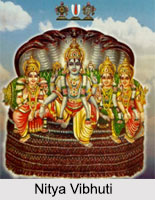 Concept of Nitya Vibhuti is admitted as one of the 6 metaphysical categories of the Vishishtadvaita Vedanta. It constitutes an essential doctrine of Vaishnavism. Vedanta Desika defines Nitya Vibhuti as a substance constituted of pure sattva, while it is different from the cosmic matter comprising the three gunas. It is also defined as a substance constituted of pure sattva, while being self-luminous.
Concept of Nitya Vibhuti is admitted as one of the 6 metaphysical categories of the Vishishtadvaita Vedanta. It constitutes an essential doctrine of Vaishnavism. Vedanta Desika defines Nitya Vibhuti as a substance constituted of pure sattva, while it is different from the cosmic matter comprising the three gunas. It is also defined as a substance constituted of pure sattva, while being self-luminous.
In Vaishnava treatises the term Nitya Vibhuti is applicable to the eternal, transcendental universe as distinguished from the physical universe which is named as "Lila Vibhuti". In Vaishnava terminology, the word "Vibhuti" means divine wealth or glory. In other words, all that belongs to the supreme Lord is His Vibhuti. That which exists eternally as His glory is named "Nitya Vibhuti".
Characteristic of Nitya Vibhuti
According to these definitions, the first essential characteristic of Nitya Vibhuti is that it should be constituted of pure sattva. Sattva generally refers to one of the three qualities of cosmic matter, viz., sattva, rajas and tamas. Prakriti and all its material products are always characterised by these qualities (gunas) in varying proportion. It is not this sattva quality that is referred to by the term of Suddha Sattva of Nitya Vibhuti. On the contrary, it refers to a different type of sattva which is regarded as absolutely free from the tinge of rajas and tamas. This would mean that there are two types of Sattva - "Suddha" which does not possess even in the slightest degree rajas and tamas and "Asuddha" which is associated with rajas and tamas. The prakriti and all its evolutes is characterised by the latter, whereas the pure sattva consists of the former.
This brings out the second characteristic of Nitya Vibhuti that it is other than prakriti comprising three gunas. It is, therefore, characterised as "Swayampra Kasa" or self-luminous to emphasise the spiritual character of Suddha Sattva as contrasted with the material substance. It thus follows that Nitya Vibhuti is spiritual substance constituted of pure sattva quality.
In Vaishnava literature, the terms Nitya Vibhuti and Suddha Sattva are generally used as synonyms, because all that exists in the realm of Nitya Vibhuti is made of Suddha Sattva.
Nature of Nitya Vibhuti
According to the Vishishtadvaita, Nitya Vibhuti is infinite in so far as its upper limit is concerned. As regards the lower limit, it does not extend beyond the cosmic universe constituted of three gunas. Though it is self-luminous, it is categorised as "Achetana" or non-sentient, as distinct from Ishwar and Jiva, which are "Chetanas" or sentient beings.




















